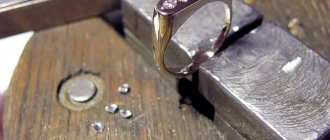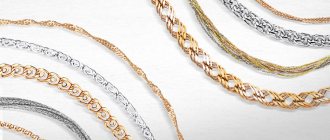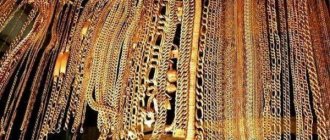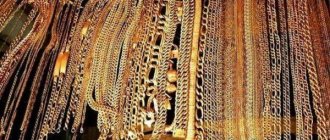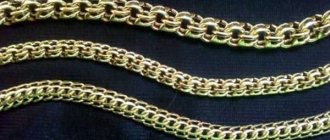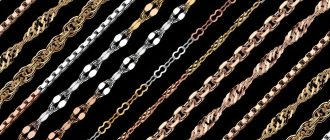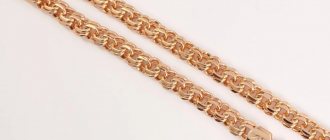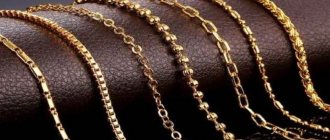Gold chains are one of the most popular jewelry items among people of all ages. This laconic decoration can be an ideal basis for decorative pendants or an independent element that attracts attention. The type of weaving of gold chains influences how the final version of the product looks. The more elaborate and intricate they are, the more sophisticated the decoration will be, and it does not require any additions. If you are faced with the task of choosing an option to highlight the pendant in an advantageous way, pay attention to simple and durable designs.
Some types of jewelry chain weaving are considered strictly feminine or masculine, and some are equally suitable for everyone, even children. In addition to its purely decorative function, the type of weaving affects the strength and durability of the jewelry. Some of them are easier to repair, and some, once deformed, will no longer be able to serve their owner. A detailed study of the nuances of creating gold chains and the characteristics of the types of their weaving will help when choosing a product option at the time of purchase.
Production of gold chains
According to the nature of their manufacture, chains are divided into the following types:
- machine knitting;
- manual;
- stamped.
In the first case, thin, light gold chains with small links are obtained. For their manufacture, ultra-thin gold wire is used, the diameter of which does not exceed 0.15 millimeters. The automatic link creation machine works so quickly that it produces 600 pieces in one minute. After the links are fastened together, the finished chain is calcined in a special oven. There, under the influence of high temperature, the ends of each link are soldered, which guarantees the strength of the product. If all technological processes are carried out without violating the rules, the machine-knitted chain will serve its owner for many years.
In terms of quality and reliability, machine-made gold chains cannot be compared with hand-knitted products.
The beauty of the finished jewelry and its durability depend on the skill of the jeweler. The manual method of creating products is often resorted to in small private workshops. They are also used in large enterprises, since truly exclusive products are created only by hand. When knitting by hand, you can create chains weighing up to 6 grams.
Stamped chains are produced using special dies. The shapes of individual links are pressed into gold sheet metal using stamps. Moreover, the thickness of the gold sheet does not exceed 0.3 millimeters. This type of production is less expensive and faster, and stamped chains look more voluminous, although their weight remains light. But in strength and durability they are inferior to machine-knitted and hand-knitted chains.
Making gold wire for chains
Craftsmen created exquisite jewelry from these thin twigs back in Ancient Egypt. Modern technologies make it possible to produce wire up to 3 kilometers long from one gram of pure gold. Surprisingly, ancient jewelers also possessed similar skills, although they did not have our high-precision units. During archaeological excavations in Egyptian Abydos, experts found gold jewelry made of wire, the diameter of which was equal to the thickness of a human hair - no more than a third of a millimeter!
Making twigs for knitting chains is a very painstaking work that requires attentiveness from the master. First, molten gold is poured into a mold (mold for ingots), producing a wire half a centimeter in diameter. It is stretched by passing it through several holes, the diameter of which gradually decreases.
The thickness of the finished wire varies from 0.2 to 2 millimeters.
The choice of thickness depends on what kind of jewelry the master plans to create from it: a chain, bracelet or earring loop. The expected weight of the future decoration is also taken into account - for weightless feminine ones you need the thinnest wire, and for masculine ones thicker.
When the master has received a twig of the required diameter, the formation of the links of the future chain begins. The gold thread is wound onto a special base and then removed from it to form a spiral. Then, using scissors, rings of the same diameter are cut.
Next, the craftsman manually fastens these links, taking into account the chosen type of weaving, and solders each one with solder so that they hold tightly. After this, the chain is clamped in special shafts and the links are made flat. The next stage is installing the lock and polishing the decoration.
What types of gold chains are there?
A chain can be made in different ways and from different golds. There are weaves that are made by hand, and there are those that are made by machine. Chains can also be full-weight or hollow.
How to choose a gold chain?
I’ll tell you what they are like and which one I would choose for myself, my wife or children.
What is the fineness of gold in the chain?
The fineness of gold indicates the amount of pure gold in the alloy. The most common is 585 gold, it contains at least 58.5% pure gold, the rest is impurities.
In addition to the purity, gold may differ in color. 585 standard can be red, lemon and white. The value of gold does not depend on color. White gold is no more expensive than red or lemon.
In order for a gold chain to be more accessible and attractive to the buyer, it can be made from 375-karat alloy, in which the content of pure gold is less than in the 585-karat alloy. In this way, the manufacturer can reduce the cost of the product.
Which gold chain is better to choose?
You need to choose either a beautiful or durable gold chain. If it combines both properties, it will be very expensive. Why?
A strong chain will weigh a lot. Remember your grandmother’s and grandfather’s chains, they weighed from 10 grams and looked very modest.
If you choose a chain that weighs 10 grams but looks like 50 grams, it simply cannot be strong.
But let's look specifically. Which chain would I choose for a gift:
To a man
For myself, I would choose a full-weight chain of classic weaving weighing from 20 grams. A full-length kaiser or anchor weave would suit me just fine.
Such a chain today costs about 60,000 - 100,000 rubles.
To a woman
For my wife, I would choose a full-length lava chain. It would weigh 5-8 grams, would be thin, but would wear quite well and for a long time.
If you turn off your brain and choose with your heart, of course you want to choose a hollow chain of interesting weaving. The same hollow Kaiser will look much brighter than the 20 gram full-weight version that we chose for the man.
But keep in mind that a hollow chain will begin to lose its shape after one to two years and will cause discomfort if worn constantly.
A gold chain weighing 8 grams will cost 25,000 - 40,000 rubles today.
Main characteristics of popular types of weaving
Gold chains are divided into three large classes, differing in the type of knitting:
- anchor;
- armored;
- bismarck
Each type has many more subspecies, because jewelry makers try to bring a new original idea to the classic variations. Today, experts identify more than fifty different variants of basic weaving.
Universal anchor tie
This option looks like an anchor chain, which is where the name comes from. This is the simplest type of weaving and is used for those gold chains on which pendants are worn. It is equally suitable for women, men and children. Anchor weaving is quite durable and easy to repair.
In the classic variation, the gold chain consists of oval links attached to each other perpendicularly.
A more durable version of this weave is called "sea anchor". It has a small stick-shaped bridge inside each link to strengthen it.
There is also a three-dimensional version of weaving, in which each link consists of two gold rings. This variety is called a "double anchor". Anchor-type weaving, created from round-shaped links, is “rollo” or “chopard”. The last version of the name is unofficial, but at one time it was the fashion house Chopard that made this type of knitting recognizable all over the world.
In Garibaldi weaving, the links are also round in shape, but they are forked in the middle. The type of mating and its name are associated with the legend about the spouses Giuseppe and Anita Garibaldi, active participants in the liberation movement in Spain, who were inseparable.
The "Venice" type of gold weaving is created from flat links of a square or rectangular shape. They are sequentially connected to each other at right angles, as is typical of all anchor-type chains. This option is also called “Italian”. Several links can be woven into one block at once, and therefore the Italian can be double or triple.
A variety of armored weaves
A distinctive feature of such gold chains is that all the links are polished on both sides and are attached to each other in the same plane. Externally, this jewelry resembles a small fragment of medieval chain mail. They are very strong and many people like them because they adhere tightly to the surface of the skin.
Armor weaving can consist of single, double or triple links.
Some of the most popular subspecies of this mating option are:
- nonna;
- figaro;
- rhombo;
- lava;
- rose;
- snake;
- spikelet.
“Nonna” weaving is distinguished by its grace and femininity. Each link of such products is decorated on both sides with a diamond cut, which makes the gold jewelry shine especially brightly. Nonna knitting looks sophisticated, but is also one of the most durable.
A fashionable version of armor weaving is “figaro”, or Cartier. The famous jewelry house Cartier is partial to this type of knitting, hence the second name. A distinctive feature of “figaro” is the alternation of links of different shapes or lengths in the same sequence. For example, three small links - one large, or one oval element - four round, and so on. The alternation depends on the imagination of the jewelry maker or the client, if we are talking about a private order.
Diamond weaving is characterized by the use of diamond-shaped links. This option can be double or triple, depending on the number of gold elements used. Such jewelry is durable and versatile, which is why men love them.
Women like lava weaving because its links are shaped like a heart. These decorations only come with single elements, as they are so intricately twisted that there is no need to attach more.
Another female version of armor weaving is a rose. Experts classify it as a type of medium complexity production. Although the weave looks quite voluminous, thanks to its elegance it remains light and feminine. Miniature links made of the finest gold wire create chains on which pendants that are not too heavy can be hung. And from more voluminous “roses” they create bracelets.
Both female and male types of weaving gold chains can be a snake, which is also called “snake” (from the English snake - snake) or tondo. Outwardly, it resembles a precious lace, in which all the links fit tightly to each other, creating the effect of snake scales. Products with snake weave are suitable for wearing in the form of bracelets with pendants. Gold neck chains can be single or twisted, consisting of two intertwined strands.
The unisex style includes spikelet weaving, created from links of the same size, connected so that they point in the same direction. These chains are very strong and therefore suitable for daily wear, including with a pendant.
Bismarck weaving - royal blood
Chains created using this type of knitting are considered truly masculine and status options for gold jewelry.
This type of weaving is also called “pharaoh”, “kaiser” or “cardinal”. It is very complex; most often craftsmen create such jewelry by hand.
Jewelers connect several links together in an original way, coming up with intricate and very durable options. It is almost impossible to tear these decorations, unless the lock gives way. Therefore, the Bismarck can be worn every day. Another thing is that such pretentious decoration may not suit everyday costumes.
There are several popular varieties of this type of weaving gold chains:
- python;
- Arabian Bismarck;
- Byzantine weaving.
The python, or “American”, resembles a huge snake in its appearance. But, unlike an armored snake, in which all the links are carefully adjusted to each other, the python is characterized by an openwork weave. Visually, such a chain looks airy and light, but breaking it will be incredibly difficult.
Such jewelry is considered heavy; the minimum weight of a gold “python” starts from 15 grams. If you choose a thin model, then it can be combined with gold crosses or amulet, with a pendant. More massive jewelry is recommended to be worn without any additions.
The traditionally masculine version of gold weaving is the Arabic Bismarck. Its key difference is in the appearance of the links, which resemble Arabic letters assembled into ligature (Arabic writing). This is a durable weave of medium complexity that can be worn every day if desired.
Byzantine weaving, nicknamed fox tail for its visual resemblance to the tail of a furry animal, looks original. This type of knitting is used to create massive gold chains. It is based on identical round or oval links of the same size and type. The master weaves them together in a fantasy way, thanks to which the jewelry shimmers under the rays of the sun.
Most often, such jewelry is purchased by men, but experts classify Byzantine weaving as a unisex style.
Variations on the theme of anchor weaving
Even anchor knitting has its own variations. This suggests that the type of weaving is developing and acquiring new colors. Common variations include:
- Marine gold chain. Of course, at first glance, it may seem that these are the same thing. But in jewelry, and even in maritime affairs, chains look different. The thing is that the marine chain has jumpers in the links in the middle. This helped the sailors, since the chain did not get tangled and the links did not rub against each other. The jewelers also liked the idea and implemented it into a piece of jewelry. A chain with jumpers looks more complete, is great for both men and women, and does not require an additional pendant.
- Double and triple anchor. The essence of weaving is the same, only several links are used that are connected to each other. Thus, the decoration becomes more massive and voluminous.
- Rollo or belzer is a type of anchor weaving that is made from round links. It is also universal, suitable for pendants. This weaving is also called Chopard, in honor of the fashion house of the same name that produces such jewelry.
- Garibaldi or double rollo - this variety is named after the Italian family who were inseparable until death and went through all the trials of life. Another name for mating is Italian. It consists in the fact that instead of one ring, two are connected at once in a link. Each link is a forked ring. The Italian is more preferred by women because the chain has an original design.
- Venetian weave or Venetian weave is also a common type of jewelry design. A modification of anchor knitting consists of using square or rectangular links. Of course, the chain looks more strict, but this also gives it a certain charm. And the products themselves are more suitable for men. The chain can be made either massive or more fancy.
- Cord weaving belongs to the group of anchor weaving. According to the technology, several links are connected at once by jumping over 2-3 links. The products are often found in jewelry stores and have a twisted shape, so from a distance they do not at all resemble a simple type of knitting.
Jewelers tried to add fantasy to this knitting technology. Among the resulting options, “Aurora” and “Hawaii” stand out. In them, round links are connected to each other, several pieces at a time. Therefore, the chain turns out to be as voluminous as possible, almost round. This variety is worn as an independent decoration without a pendant.
Anchor chains and bracelets are made from mainly 585 gold. This sample is the most reliable; if the gold content is higher, then such a chain will deform over time under the weight of the weight. And medium samples keep their shape optimally, their appearance does not change over time.
There are almost no defects in anchor weaving and its varieties; the links are large and can be seen with the naked eye. The clasps of such products also do not require special attention, since any of them can withstand the load of the weight of the jewelry.
Of course, anchor weaving appeared first, so it is now difficult for them to surprise and express individuality. But sometimes, when choosing a gold chain or bracelet, you want to choose the most practical and at the same time stylish option. For such cases, anchor weaving and its varieties are perfect.
Graduation of gold chains by strength and reliability
Even among jewelry with light weight and thick links, you can choose several durable options that are good for daily wear. For example, women can purchase a chain created by weaving a spikelet. Such products are strong and do not get tangled. Venetian weaving is also durable and easy to repair, like all other “anchor” weavings. In the event of a breakdown, a specialist will be able to easily replace or solder the broken element. These chains hold the weight of pendants or pendants well. But you need to take into account that Venetian weaving looks best if the links are small, massive options look rough.
Of the more massive types of knitting, “Figaro” is distinguished by its durability, which is often chosen by men. In general, all armored chains are durable and easy to repair. But it is important to check with sellers how the decoration was made. If you plan to purchase a stamped chain, be prepared to regularly remove it at night. Such models are at risk of deformation, and they are not easy to repair.
You need to be careful with snake weaving, since its individual fragments often get tangled together. Sometimes the links can become so twisted that the jewelry cannot even be repaired. Therefore, you need to wear them carefully and ensure the safety of the elements.
Remember: the simpler the design of a gold chain, the greater the chance of repairing it if necessary, and the less it will cost you.
DIY jewelry repair
If your chain breaks, it is best to immediately take it to a jewelry workshop, since it will be difficult to correct the situation with your own hands. But if you or someone in your family is familiar with a soldering iron and other tools that require precision, you can try to fix the problem yourself. The easiest way to deal with a defect in a chain connected with an anchor type of weaving. To restore a damaged link you will need the following set of tools and materials:
- an old gold chain or other deformed gold item;
- miniature vice;
- gas-burner;
- round nose pliers;
- blowpipe;
- asbestos sheet;
- sewing needle;
- needle file (small file with a fine notch).
For high-quality work, a small jewelry vice is important that will securely hold the product.
Clamp the torn section of the chain in a vice, and connect the links of the two torn ends with a needle - just push it through them. Place the vice on an asbestos sheet, which will prevent fire during further manipulations. If you are dealing with a massive gold chain that holds its shape well, then you can not fix it in a vice, but simply put it on asbestos. But in this case, secure the links with a needle. Heat the rupture site with a gas torch. Direct the flame to this point using a blowpipe.
As soon as the metal turns white, place a small piece of gold on the heated section of the chain, which will be enough for soldering. You need to wait until it completely melts, spreading over the deformed area of the product. Allow the gold to cool and harden. After this, use small wire cutters to remove the excess amount of gold solder and process the solder with a file. If you did everything correctly, the links will be sealed. In a similar way, you can, if necessary, reduce the length of the product. Only for this you will first need to unfasten the required number of links.
Gold chains are basic jewelry for men and women. Depending on the type of weaving, they can be an everyday accessory or a luxurious accent to an evening outfit. When choosing this jewelry, you need to focus not only on its beauty, but also on convenience, strength and durability.
Consider in advance whether an ornate interlocking chain would suit you for everyday wear. Keep in mind that if it breaks, repairing it can cost a lot of money.
3.4. Anchor chains
Home / Publications / Literature / Bookshelf / Handbook of maritime practiceAnchor chains are used to connect the anchor to the ship. Depending on the weight of the main anchors and displacement, ships are equipped with anchor chains with a caliber of 11 to 100 mm. The gauge of the anchor chain is the minimum cross-sectional diameter of the common link of the anchor chain. The anchor chain is made up of 4-12 segments 25-27 m long, called bows. The bow adjacent to the anchor is called anchor; the bow connected to the ship's hull is the main bow. The anchor chain links located between the anchor and main chains are called intermediate. Anchor chains with a caliber of 11 and 13 mm are made continuous, without division into bows. Boats with a displacement of up to 35 tons are equipped with steel cables with a diameter of 11-13 mm and a length of 75 m instead of anchor chains.
Table 3.6
Anchor chains are manufactured in three types according to
GOST
6345-65:
I - welded without spacers with a caliber of 11-37 mm; II - welded with spacers with a caliber of 15-100 mm; III - cast with spacers with a caliber of 43-100 mm.
Calculation of strength and weight of anchor chains
.
Breaking load RP in ms of the anchor chain Test load Rpr in ms - the load that the anchor chain must withstand during testing: Weight of 100 m of the anchor chain Wc in kg: where d is the caliber of the anchor chain, mm.
Anchor chain kit
. The anchor chain links consist of links, the number of which in the link must be odd. The anchor chain links can be with or without spacers. The strength of chains with links without spacers is approximately 20% less than the strength of chains with spacers.
The general layout of the anchor chains is shown in Fig. 3.11—3.13. The anchor chain consists of 7 common, 2 enlarged, 4 connecting end links, 5 swivels and 6 end brackets.
Figure 3.11. Complete set of anchor chain without division into bows
Figure 3.12. Anchor chain kit (welded)
Figure 3.13. Anchor chain kit (cast)
The common links (Fig. 3.14, 3.15) basically make up the entire anchor chain. The dimensions of the common links for the same caliber of anchor chain are the same and do not depend on the manufacturing method.
Rice. 3.14. Common and extended link without spacer
Figure 3.15. Common and extended link with spacer
Enlarged link - a common link of the next, larger caliber. It is increased only in relation to the caliber of the anchor chain into which it is inserted.
The connecting link is designed to connect individual parts of the anchor chain. The connecting links are made detachable and are made of two types: forged - for welded anchor chains (Fig. 3.16) and cast - for cast anchor chains (Fig. 3.17).
Figure 3.16. Forged connecting link
Figure 3.17. Cast connecting link
The end link is placed only at the ends of two bows: anchor and root. It is designed for attaching the anchor chain to the end bracket and for connecting the anchor chain to the anchor chain release machine. The end link can be with a spacer (Fig. 3.18) or without it (Fig. 3.19).
Figure 3.18. End link with spacer
Figure 3.19. End link without spacer
The end bracket (Fig. 3.20) is installed at the end of the anchor chain and serves to connect the anchor chain to the anchor bracket. When connecting the anchor chain to the anchor, the end shackle pin is inserted behind the armature shackle.
Figure 3.20. End bracket
The swivel is used to prevent twisting of the anchor chain; it is included in the main and anchor bows, and the swivel pin should face the intermediate bow. Swivels are made of two types: forged (Fig. 3.21) - for welded anchor chains and cast (Fig. 3.22) - for cast anchor chains.
Figure 3.21. Forged swivel
Figure 3.22. Swivel cast
Attaching the anchor chain to the ship's hull is carried out using a recoil machine or a chewing tack.
M a c h i n e o f t h e d a t i o n of the root chain (Fig. 3.23). On the butt, rigidly connected to the body of the chain box, the upper (in the figure) pin is secured with a bracket, and the lower one with a hook; The shackle and hook are engaged. The hook with the end link of the anchor chain behind it is removed from engagement by the bracket using a special nut mounted on the screw. The forward movement of the nut is transmitted from a manual drive through a screw passing through the body and the oil seal.
Rice. 3.23. Anchor chain recoil machine: 1 - housing; 2 - screw; 3 - nut; 4, 5 — pins; 6 - hook; 7 — bracket; 8 - butt; 9 — oil seal
Zh v a k a - gal s (Fig. 3.24) - a section of an anchor chain made of common links. It is attached to the butt of the chain box using an end bracket; the second end of the cud-tack is attached to the root bow of the anchor chain with the help of an end link and a verb-hook. The tack must be of such length that when the anchor chain is completely etched, its tack is located between the deck fairlead and the capstan.
Rice. 3.24. Chew-tack: 1 - verb-hack; 2 - end link; 3 - common links; 4 - end bracket; 5 - butt
Marking of anchor chain. To determine the amount of etched anchor chain, every 20 g, starting from the anchor bracket, annealed wire marks are applied to the link spacers. To facilitate recognition of marked links, they are colored:
20 m - one red link with a stamp; 40 m - two red links with stamps; 60 m - three red links with stamps; 80 m - four red links with stamps; 100 m - five red links with stamps; 120 m - one white link with a brand; 140 m - two white links with stamps; 160 m - three white links with stamps; 180 m - four white links with stamps; 200 m - five white links with stamps; 220 m - one red link with a stamp, etc.
Forward Contents Back
